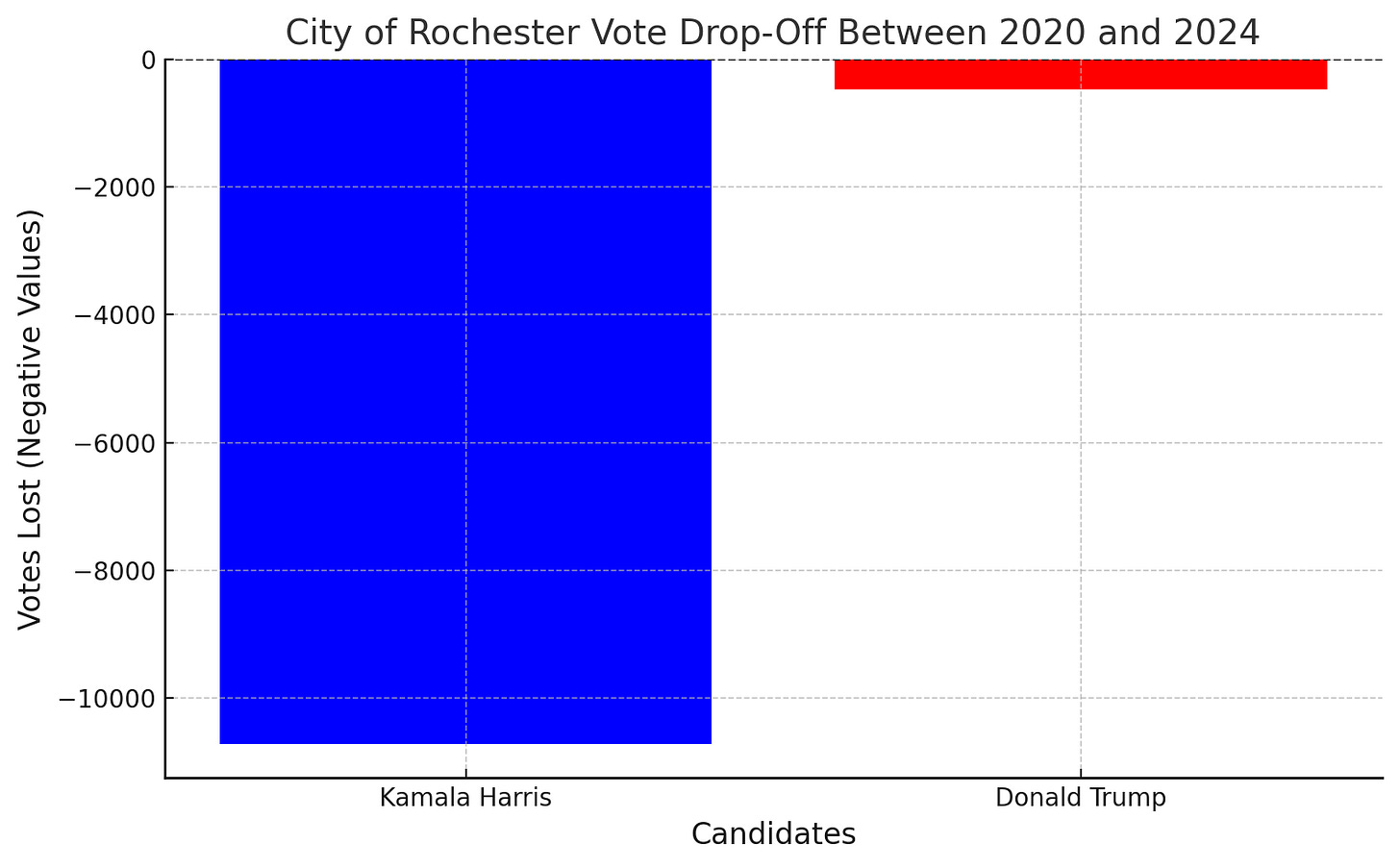Monroe County’s Missing Voters of 2024
Results reflected a national trend of Democratic voters staying home.
After the election, the Monroe County Democratic Committee celebrated significant victories, including retaining the 25th District congressional seat, holding all state legislature seats, and likely picking up a State Supreme Court seat.
A narrative quickly emerged: Monroe County Democrats had successfully resisted the red wave that returned Donald Trump to the presidency. But that story is only partially true.
The Good News for Democrats
Monroe County voters overwhelmingly supported Proposition One, enshrining reproductive rights in the state constitution. This was a resounding victory, especially given the fierce opposition and spread of misleading information. Additionally, Democrats are poised to secure one of two State Supreme Court seats in an eight-county district long considered hostile to Democratic candidates.
The News That Doesn’t Mean Much
Monroe County is no longer a purple county, largely due to changes ushered in by the Trump era. Voter registration favors Democrats/Working Families Party at 42%, compared to 27% for Republicans/Conservatives. For a Republican to win countywide would require extraordinary shifts among Democrats and independents—a tall order. Increasingly, local primaries are the real battlegrounds shaping Monroe County’s leadership.
Adding to the Democratic advantage is gerrymandering. Democrats would have to go out of their way to lose most of their legislative seats. For instance, in State Senate District 56, there are twice as many registered Democrats as Republicans. State Senate District 55 also boasts a significant Democratic advantage. Similarly, in Assembly Districts 136, 137, and 138, Democrats far outnumber Republicans.1 The 135th Assembly District remains the only competitive district, though it was redrawn this redistricting cycle to favor Democrats by replacing Webster with Pittsford.
This isn’t to diminish the efforts of the Democrats who won these races. None of them took reelection for granted. However, their victories reflect structural advantages, offering limited insights into national trends or future challenges.
The Bad News: Missing Voters
Monroe County mirrored national trends in one critical way: Democratic voters stayed home. Compared to 2020, 20,626 fewer votes were cast for Kamala Harris in 2024, while Donald Trump’s vote count dropped by only 3,898. Turnout declined from 78.1% to 73.7%2.
As David Wallace-Wells of The New York Times observed nationally:
“In the most Democratic places, where shrinking margins have produced a kind of liberal vertigo, Trump didn’t actually gain much support; the much-hyped surge right among urban voters was primarily powered by a Harris collapse…In the streets of New York, there probably aren’t many more Trumpers than you thought — just fewer loyal and committed Democrats.”
This trend played out starkly in Rochester. Based on unofficial results, the city saw 12,614 fewer voters in 2024 than in 2020. Turnout declined from 65.3% to 54.5%. That resulted in 10,713 fewer votes for Harris compared to Biden and only a modest drop of 471 votes for Trump.
Winning Isn’t Everything (Really)
Unfortunately, local Democratic leaders may draw the wrong conclusions from these results. If winning is the only goal, then perhaps Democrats have little to worry about in the short term. But governing isn’t just about winning—it’s about accountability, representation, service-delivery and problem-solving.
Despite a crowded ballot, voters faced limited meaningful choices. Many races were effectively decided before Election Day, and in the presidential contest, New York’s deep-blue status made Harris’s electoral votes a foregone conclusion.
When voters lack genuine choices, government becomes less accountable and less responsive to the people it serves. This creates fertile ground for complacency, poor policymaking, and even corruption. We have to admit that we have these issues on the local level. Ezra Klein discussed Democratic “status quo” approach to governance in this piece:
I’m worried about how absent the huge accomplishments of the Biden administration — the Inflation Reduction Act, the bipartisan infrastructure bill — how absent they are in people’s lives. In part because the way government works and spends and delivers under Democrats is very slow.
If you look at the election, Democrats lost the most support in blue states and blue cities. They lost the most support in the places where people are most exposed to Democratic governance — and yeah, Democratic institutions…
And so I don’t want to see Democrats become a party of the institutional status quo, and that is a political necessity, too. Democrats left a huge opening for the right by refusing to admit what so many Americans constantly see and feel: The institutions that have power over them are often doing a really bad job.
We need systemic reforms that give people more choice and control, including open primaries, ranked-choice voting, independent redistricting, and campaign finance reform—all of which could reinvigorate voter engagement and lead to better government. That will all take time to implement, if it ever happens.
For now, the sharp decline in voter participation should serve as a wake-up call. Even in a blue county, an engaged electorate strengthens not only the Democratic Party but also is crucial for good governance.
Correction: I had mistakenly included the 135th in the list of lopsided assembly districts when I published. It is the only Monroe County that is competitive, which I also noted. (Both cannot be true.)
Correction: An earlier version had slightly lower voter turnout because the initial results released by the Board of Elections did not include other candidates, blank and voided ballots. The recently-posted election certification indicates 368,343 voted out of 499,763 registered voters in November. The BOE will post a turnout report next year that will have final data.






I would suggest that the democrat staying home is more about what is going well that doing a bad job. In smaller organization it became clear to me that when people are doing well, they do not turn out for votes. The economic indicators this year look good... GDP is up, inflation has been down for 18 months, interest rates easing, business starts are strong, market returns are strong, unemployment is low, wages have been increasing more than inflation.
While that may not be felt by everyone - yet - it is an overall picture of what is going well, and when things go well people are not coming out to vote. So perhaps the nut to crack is how to motivate voters when they feel like things are going well. With a national % of around 1.7% difference from Trump to Harris, turnout is everything. Paul Weyrich back in 1980 made it clear that the way to govern by minority is about getting a specific group to vote, to motivate them with single simple issue concerns and overall have less turnout. That seems to ring true in 2024 and project 2025 is now getting the impetus they are sought.